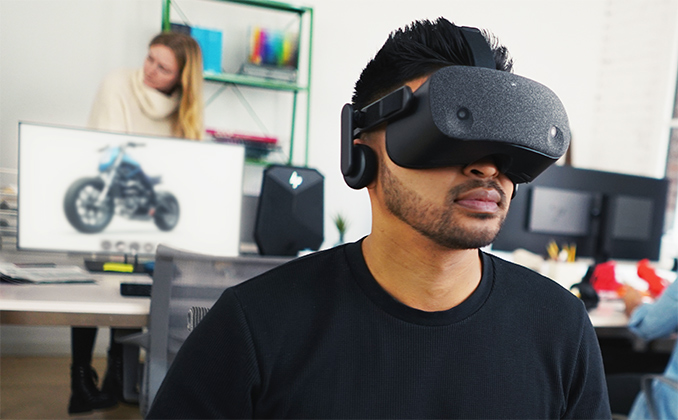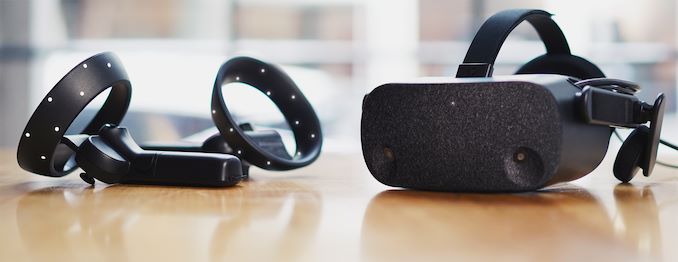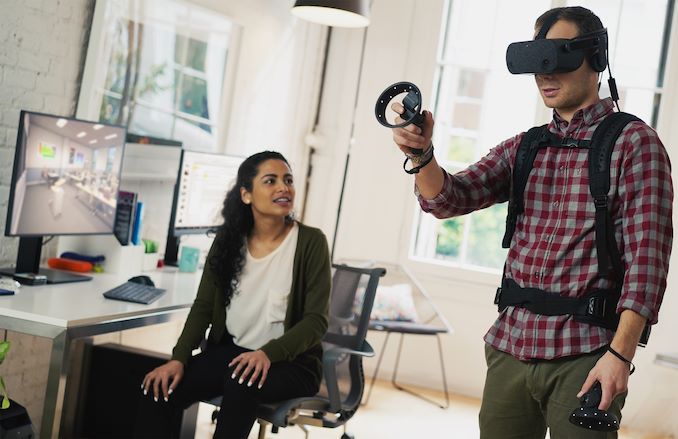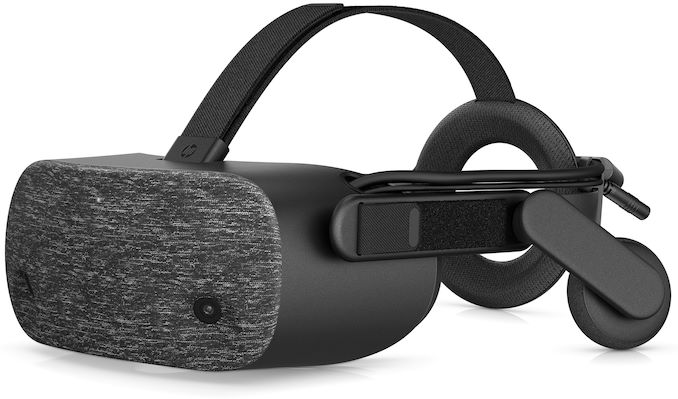HP Reverb Virtual Reality Headset: A 4K HMD with 6DOF
by Anton Shilov on March 20, 2019 5:00 PM EST
Numerous companies are making attempts to drive VR technology to the commercial space. HP this week introduced its first AR/VR headset that was designed from the ground both for consumer as well as for commercial/professional applications.
The HP Reverb VR headset is outfitted with two 2.89-inch screens featuring a 2160×2160 resolution per eye (4320×2160 combined resolution), a 90 Hz refresh rate, and a 114-degree field of view. The head mounted display (HMD) comes with a built-in inside-out 6-degree-of-freedom (6DoF) positional tracking and therefore does not need any external sensors. It also has its own spatial audio headset, and two front-facing cameras to enable augmented reality applications. The device also comes with Bluetooth connected motion controllers that are pre-synced to the headset to simplify setup.
To make the Reverb VR HMD more comfortable to use, HP outfitted it with a rather unique adjustable headstrap featuring a built-in cable management and enhanced ergonomics to compensate the weight and ensure that the headset does not fall.
HP’s Reverb headset requires a rather powerful PC with a DisplayPort 1.3 connection to ensure proper performance at a 4320×2160 resolution with a 90 Hz refresh rate. HP says that the head-mounted display is fully compatible with its Z VR wearable backpack PC, but keep in mind that certain programs might need a high-end graphics card only found in gaming/workstation desktops.
The HP Reverb VR headsets — both the Professional and Consumer Editions — can work perfectly with Windows Mixed Reality, and SteamVR applications (which are mostly games). The only hardware difference between the two versions is their bundle: the Pro model comes bundled with a 0.6-meter cable for HP's Z VR Backpack PC as well as a cleanable face cushion.
HP will start selling its Reverb VR headsets in late April. The consumer version will cost $599, the price of the professional model will be disclosed at a later date. Both HMDs will be covered with a one-year warranty with optional care packs for the Pro flavor.
Related Reading:
- Japan Display Develops VRM-100 VR Headset with 3DOF for Business Users
- HP Windows Mixed Reality Headset, Professional Edition, Coming March
- VR Startup Varjo Announces Shipping of High Resolution Headset Prototype, Aimed at Professional Markets
- Windows Mixed Reality Headsets Gain SteamVR Support, a Library of VR Games
- HP Expands Commercial VR Strategy: Z VR Backpack and Immersion Centers
Source: HP















42 Comments
View All Comments
bubblyboo - Wednesday, March 20, 2019 - link
Well the specs are much better than the new Rift, but the price is also $200 higher.bubblyboo - Wednesday, March 20, 2019 - link
Although since it's HP, the street price will probably drop in half in a few months.mckirkus - Wednesday, March 20, 2019 - link
Brutal, released right after Oculus' announcement. This has 9.3 million pixels vs. the Rift S which has 3.7 million. Granted it costs $200 more, but Oculus' rebranded Lenovo headset (with some upgrades) means serious VR nerds will quickly abandon the Facebook software ecosystem. Time will tell if that's a good plan for FB/Oculus.Applejackson - Wednesday, March 20, 2019 - link
Facebook's target audience isn't "VR nerds". The company that wants 6 billion people on Facebook wants at least half of them to buy into VR. The VR nerds will always be looking toward the next tech that's out of financial reach for most consumers.Beaver M. - Thursday, March 21, 2019 - link
Making nerds happy is the only way to make a mainstream technology out of niche technology.PeachNCream - Thursday, March 21, 2019 - link
That's not entirely true, but it is a safe bet most of the time. Nerds are poor to awful when it comes to personal finance, after all.Beaver M. - Thursday, March 21, 2019 - link
Its not about their finance, its about mouth propaganda. They will tell everyone how great this is and others will believe them, because well... they are nerds.PeachNCream - Friday, March 22, 2019 - link
It is about personal finances. Nerds (tech enthusiasts is probably a better term to use here given that some people might take being called a nerd as insulting) are the sorts that will place a priority on buying a new gadget even if it prevents them from reaching basic financial goals like building emergency savings, paying down existing debt, or putting a sufficient amount into a variety of investment vehicles for retirement. The propaganda only comes after a purchase decision is made and said person feels compelled to praise the gadget, partly to shield their own psychological state from buyer's remorse and partly to seek the approval of or impress others with the things they own. In short, the show and tell comes after the personal finance error.Beaver M. - Saturday, March 23, 2019 - link
Yeah sure, works exactly like that with their PC components too, huh?SleepyFE - Monday, April 1, 2019 - link
Yes